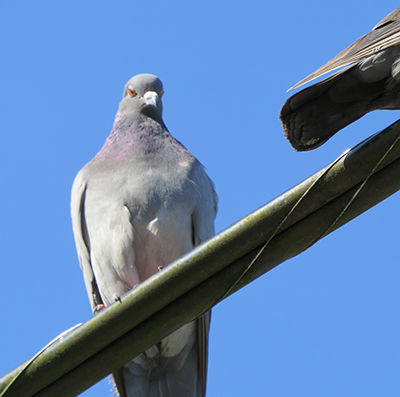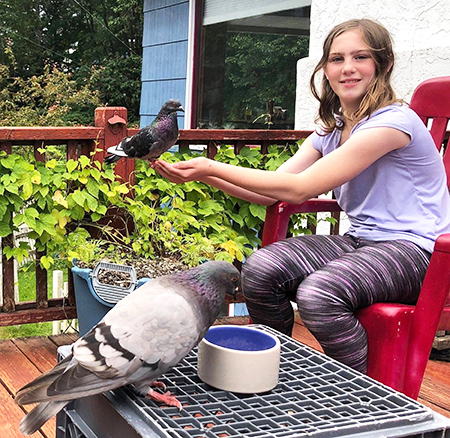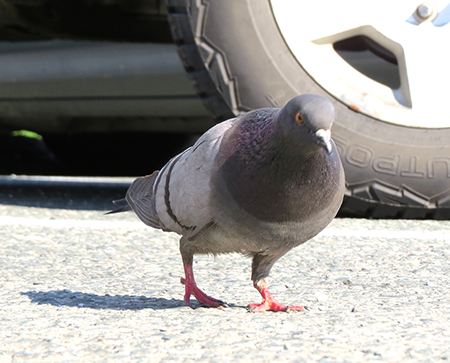Alaska Fish & Wildlife News
August 2025
Why do we Only See Pigeons in Town?
Ask a Wildlife Biologist

“Were pigeons deliberately introduced to Alaska? Why do we only see them in towns? I never see them in the wild.”
Pigeons were introduced to North America in the 1600s the same way dogs, goats and cats were introduced – as domesticated animals. They were domesticated at least 5,000 years ago in Egypt and throughout the Middle East, and have moved around the world as people moved. They were kept for food, as pets, and for their remarkable homing ability, which made them valuable as messengers. They are known to many people as carrier pigeons or homing pigeons. Like most domesticated animals, they are very trainable. Pigeons were key subjects for famed psychologist B.F. Skinner, who taught pigeons to play ping pong and other tricks and tasks in his work on behavior.
They are also known as rock doves, and as their appearance indicates, they are closely related to doves. “Paloma” is the word for both dove and pigeon in Spanish. Pigeons are on the Alaska “clean list,” the official list of animals that may be kept as pets and livestock. The city birds we are so familiar with are (the descendants of) domesticated animals that are feral. While they are loved (and fed) by many urban residents, to others these feral pigeons are "rats with wings."

Wildlife biologist Julie Hagelin works with a variety of bird species and noted that pigeons’ introduction to Alaska is related to their status as pets.
“Probably some were released by kindly owners, and I'd imagine there's the possibility that they have expanded their range through human-habitated areas within the state, but also from the Lower 48. A mix of both, I'd expect.”
Getting to Alaska from the Lower 48 would mean passing through a lot of wild country. But pigeons are strong fliers and can top 85 miles an hour. Not that pigeons were deliberately migrating to Alaska, but farms, cattle feedlots, and agricultural areas would help them expand their range as they moved between the human environments they favor.
Biologist Arin Underwood also studies and works with birds and has written many articles for Alaska Fish and Wildlife News. She said in the wild, pigeons’ preferred habitat is caves, cliffs, and crevices. They have been found in rural environments in other parts of their large range, like sea cliffs in Scotland, and canyons in the Middle East. But in North America it looks like they are mainly in human environments - cities, farms, bridges, and highways. They avoid areas with tall dense vegetation. Their natural affinity for cliffs and canyons is a big reason why they like cities, with churches, towers and buildings.

A Polish study found them in much higher numbers in towns surrounded by agricultural landscapes rather than those surrounded by forest. Their highest density was in cities with tall buildings and human-related food sources.
Underwood wrote, "They seem to prefer maritime and agricultural habitats and are not found far away from humans or agriculture. I’d say most of Alaska isn’t good habitat for them as they likely avoid forests due to the threat of raptors and the need for a reliable food supply that usually only humans can provide. Their eBird sightings in Alaska seem to be centered on Anchorage and the Kenai, with reports going up the highway to Denali, and a few on the Seward Peninsula, Kodiak, Southeast, and a few in Prudhoe Bay. Urban environments likely provide the closest approximation to their preferred nesting sites of cliffs with far fewer predators and more abundant food. The further they get from these sites the more likely it is they will encounter predators or have fewer food options."

Tracking flycatchers - Julie Hagelin research project
Arin Underwood: Swallows in Alaska, Shorebird festival Tracking Lesser Yellowlegs A Collared Pika in winter
Please email riley.woodford@alaska.gov if you have an "Ask a Wildlife Biologist" question.
Subscribe to be notified about new issues
Receive a monthly notice about new issues and articles.
